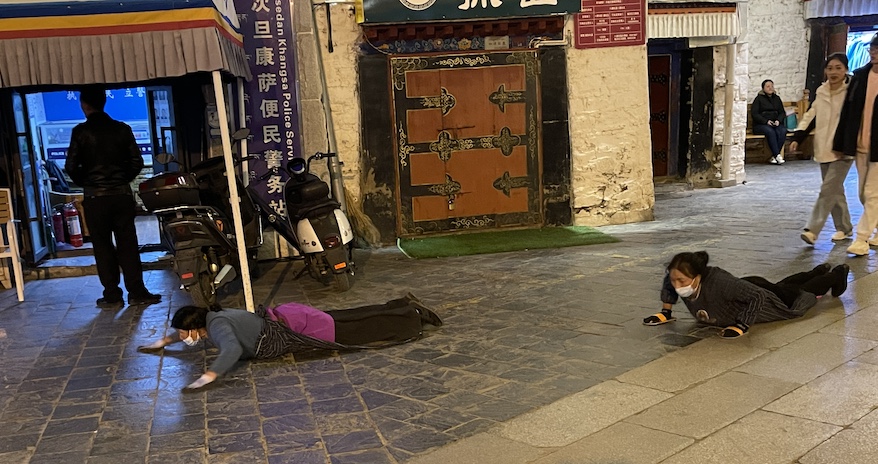
Tibetan Buddhist pilgrims prostrate themselves in prayer before rising to make their way slowly forward on Barkhor Street to Jokhang Temple, the most sacred pilgrimage destination in Tibet. Photo by David DeVoss
Lhasa: Elevation 12,000 ft or 3,650 m
By David DeVoss
In Lhasa’s Barkhor Square, the weathered Tibetan woman softly intoning a Buddhist mantra fell to her knees, looked fervently skyward and then lunged face down on the pavement, oblivious to the commercial life surrounding her. After a few seconds of prayer, she rose stiffly, moved two steps forward and repeated the process.
Shoppers flowed around her with scarcely a sideways glance because Lhasa residents are used to seeing prostrate pilgrims lost in prayer. Indeed, more than a dozen other pilgrims wearing leather aprons, knee pads and wooden blocks attached to their hands were scattered around the corner and down the street. Older Tibetans with sunbaked faces seemingly hewn from gnarled trees spun hand-held prayer wheels while trudging onward reciting the Sanskrit incantation Om Mani Padme Hum. For all the pilgrims moving clockwise in their circumnavigation of the square the destination was the same: Lhasa’s Jokhang Temple.
Some of the pilgrims, several from as far away as China’s Qinghai, Gansu and Sichuan provinces, had been on the road for months. They were followed closely by friends or relatives who provided nightly shelter and sustenance with funds donated by neighbors back home.
One mile north of Barkhor Square, where Jokhang Temple is located, Potala Palace rose majestically from atop Red Hill in the center of the Lhasa Valley. Bathed in perpetual illumination, the massive red and white complex is a beacon both day and night. Its likeness appears on the back of the 50 Yuan note. Along with the Great Wall, Potala is one of China’s most iconic structures.
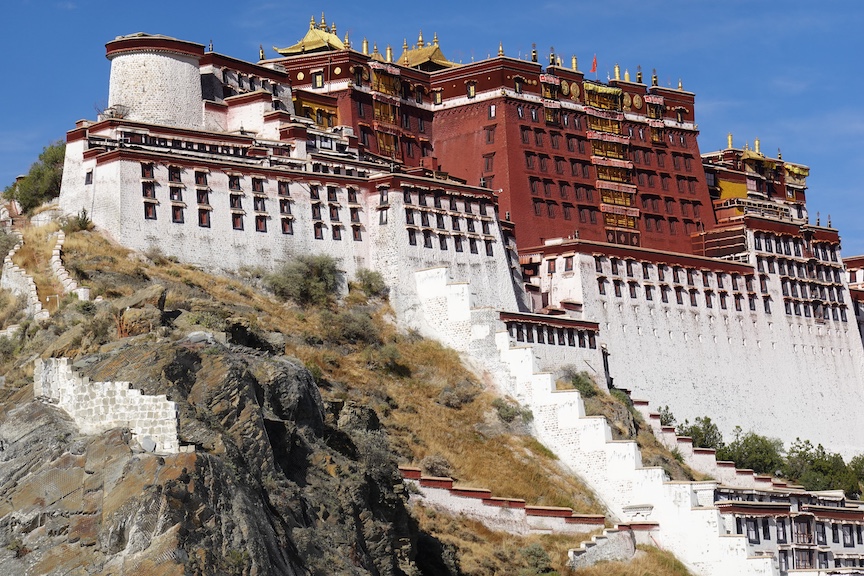
Potala Palace in Lhasa. This is the same image that appears on the Chinese Renminbi. Photo by David DeVoss
Unifying the World’s Rooftop
Potala Palace was constructed in 631 AD, for Songtsen Gambo, the king who founded the Tibetan Empire and introduced Buddhism to the Roof of the World, It was rebuilt after a 17th century fire into two contiguous palaces that served as the personal home, diplomatic headquarters and administrative center of Tibet’s Dalai Lamas, who by then had both temporal and spiritual authority. Over a 317-year period it was home to ten Dalai Lamas, eight of whom are entombed there in gilded stupas. The tomb of the 5th Dalai Lama responsible for the 1641 rebuild is coated with 4.1 tons of gold and encrusted with more than 18,000 precious jewels.
There are 1,200 chapels in the Potala Palace of which 20 are open to the public. Ask your guide to point out the Eastern Sunshine Chapel. It’s a regally appointed chamber with a golden throne. Here during a massive public uprising in 1959 Chinese Vice Premier Chen Yi told 24-year-old Dalai Lama Tenzin Gyatso that Beijing would be annexing Tibet and assuming his administrative authority. “Tibet’s young spiritual leader excused himself and went into a nearby hall presided over by the Dharma Protector,” whispered my Tibetan guide. “There, seated on a bed surrounded by six silver statues of Mahakala, he prayed for guidance and was told to escape to India that night.”
Today, Potala Palace is a massive 13-story museum. At an elevation of 3,650 meters, it is the highest palace in the world. Want to get to the top to take a panoramic photo of Lhasa? You’ll have to climb 350 irregularly shaped stairs. Officially, daily attendance is limited to 2,300 who pay $30 to enter. But during the six-month high season from May to the end of October, close to 5,000 tourists a day may slowly walk single file past stupas and chapels attended by chanting monks.
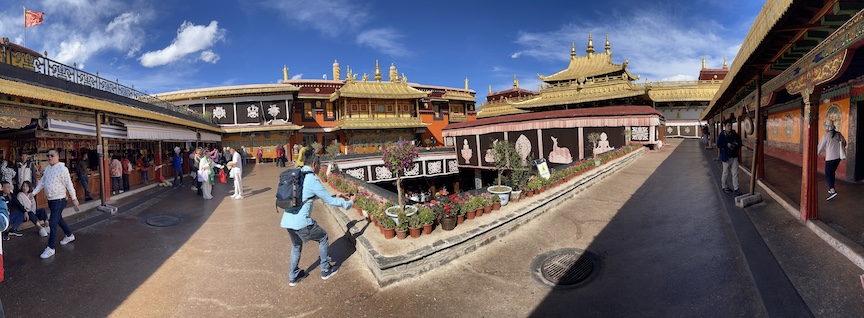
The view from the roof of Jokhang Temple is not as spectacular as that from Potala Palace, but it does offer shopping. Photo by David DeVoss
Visitors all hear the same story. It’s about King Songtsen Gampo, who in 640 AD asked Tang Emperor Taizong for permission to marry Chinese Princess Wencheng. The emperor sends his beautiful and intelligent relative to Lhasa, along with a dowry of tea, medical books, seeds of grain capable of adapting to high altitudes and instructions on how to manufacture paper and ink. The rest of the tale depends on whether a Chinese or Tibetan guide is telling it.
Chinese guides say the story shows how China used a diplomatic marriage to establish sovereignty over distant barbarians who might have destabilized the Silk Road. Tibetans smirk when they hear this and explain, sotto voce, that China’s actions were those of a vassal state showing deference to a celestial Kingdom that controlled the 2.5 million sq. km. (1 million sq. miles) Tibetan Plateau.
All Quiet on the Silk Road
Historians agree that trade on the Silk Road from Xian across the Tibetan Plateau increased dramatically following the marriage. They also believe Wencheng’s ménage à trois relationship to Songtsen (his other wife was Nepalese) was a happy one.

Shops around Lhasa’s Barkhor Square sell a variety of fashion accessories. These shoppers are Tibetan women whose wide-brimmed hats are designed to protect their faces from the intense sunshine. Photo by David DeVoss
Perhaps that’s because they spent most of their time at Jokhang Temple, a modest place more attuned to Buddhist spirituality than the claustrophobic seat of imperial administration up on the hill. Foreign travelers who receive special permission to visit Lhasa (a normal Chinese visa is insufficient) must present that certificate along with their passport at a police checkpoint before being allowed to enter Barkhor Square. Nobody in authority speaks English so hiring a multilingual guide is a wise investment since the square is the heart of Lhasa.
Exotic and welcoming at the same time, the easily walkable area includes dozens of stores selling Tibetan clothing, Buddhist artifacts and unusual handicrafts. Colorful restaurants and coffee shops are strung out along streets interspersed with banks of embossed metal prayer wheels being constantly spun by a succession of Han Chinese and Tibetan tourists. Older visitors chant Om Mani Padme Hum as they spin the wheels hoping to purify their negative karma. Vacationing Chinese millennials prefer to rent embroidered silk costumes and use prayer wheels as props for their blog posts.
Despite the prevailing tranquility, Lhasa is not without tension. A few steps from the temple is a small apartment building that serves as housing for monks. In front of the entrance, adjacent to an elevated trough for washing clothes, is a billboard with a photo of Chinese Communist Party General Secretary Xi Jinping next to his admonition: “All monasteries should follow the constitution and help build the big dream of China.”
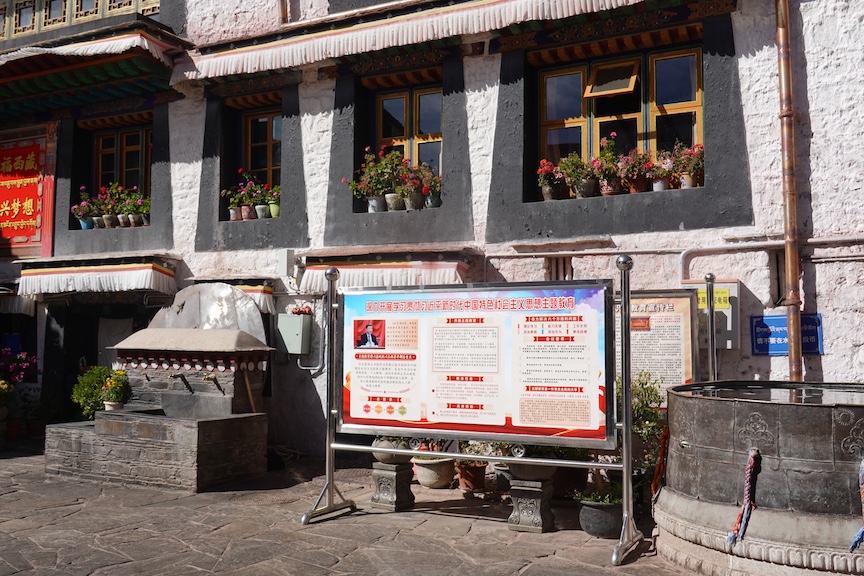
Chinese Communist Party news updates from Xi Jinping are regularly updated on bulletin boards placed outside the entrance to apartments used by monks working in nearby Jokhang Temple. Photo by David DeVoss
Here Come the Chinese
Lhasa’s residents are ready to help China become more prosperous. But they are concerned about their population’s changing demographics. Twenty-five years ago, Lhasa was a Tibetan city. Today, nearly half of the urban area’s 465,000 residents are Han Chinese, who are building massive high-rise condominiums in the western part of the city.

Before and After. Tibet’s capital of Lhasa once was a low-rise city of three and four-story buildings as those (on the left) bordering this street branching away from Barkhor Square. Today, Lhasa’s suburbs (right) increasingly are covered by towering apartment developments that resemble those surrounding coastal China’s provincial capitals. Photo by David DeVoss
To accommodate the new arrivals, Lhasa’s elementary and secondary schools now teach in Chinese, which also is the language of instruction in monasteries where many young boys study to become monks. The self-exiled 14th Dalai Lama is 89 and many wonder what will happen when he dies.
With new leadership comes a new direction, but most believe Tibetan Buddhism will continue to exist, if only because there are 400 million practicing Buddhists in China. Beijing remains sensitive about the excesses of the decade-long Cultural Revolution and has partially subsidized the rebuilding of hundreds of temples defaced and looted by the Red Guards. CCP policy is to isolate and diminish the moral authority of Tibetan Buddhism while encouraging refurbished monasteries to flourish as tourist destinations with gift shops selling everything from amulets, incense and books to jewelry and figurines.
At the Shoe Dulpal Tibetan Handicraft School on Lhasa’s Baerku Road, 140 Tibetan artisans spend their days carving sutra prayer books, painting thangka scrolls and burnishing statues of Tibetan Buddhist deities. Located in a building built in 1640, the employees spend decades practicing their craft. “Most of our clients are monasteries hoping to replace what was destroyed decades ago,” says school spokesman Jaunpa Li. “We have to get permission from China’s government first, but when complete these prayer sutras will belong to Litang Monastery in Sichuan.”
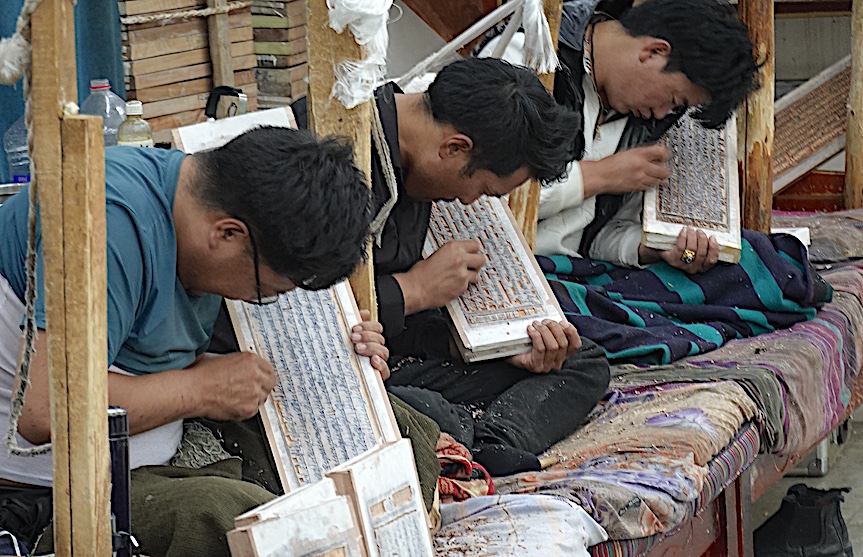
Student artisans at the Shoe Dulpal Tibetan Handicraft School in Lhasa employ traditional methods to incise Buddhist sutras on wooden panels intended for use by praying monks in monasteries. Photo by David DeVoss
Lijiang: Elevation 7,874 ft or 2,400 m
The quickest way to Lhasa is a direct flight from a gateway city like Shanghai, Beijing or Guangzhou. But this means flying from sea level to an elevation of 12,000 ft. (3,650 m). Tibetans embrace new arrivals with a white silk shawl called a katag. But hours after arrival you may wish you had received a bottle of oxygen instead. Most hotels sell small canisters of oxygen; you need to buy several if you plan to hit the ground running. To avoid the lethargy of altitude sickness, I decided to acclimatize gradually beginning by beginning my journey to Lhasa in Lijiang at the southern end of the Tea Horse Road which connects Tibet to the Chinese province of Yunnan. For centuries, the Lijiang area flourished on the southern edge of the Tibetan Empire. Today it’s the homeland of the Naxi, one of China’s 56 ethnic minorities, yet continues to embrace many aspects of Tibetan Buddhist culture.
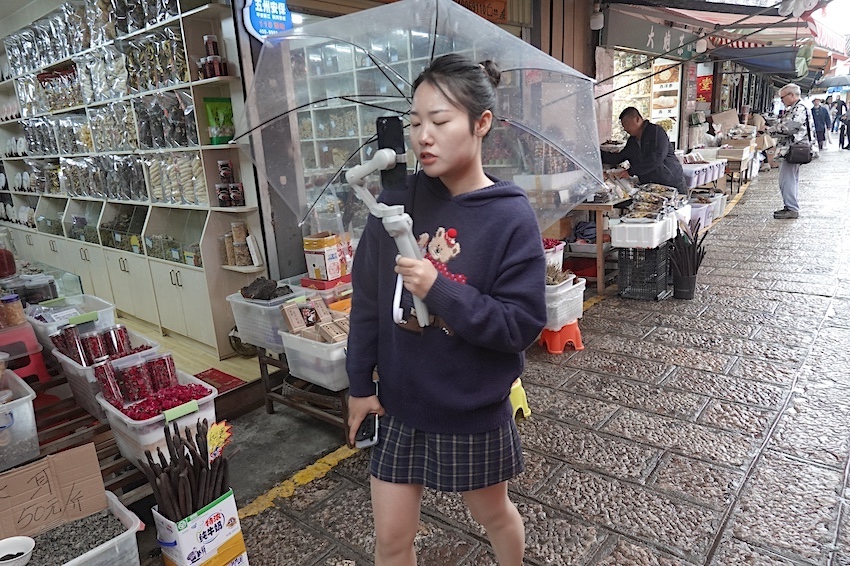
Influencers Lane in Lijiang attracts bloggers who manage to walk, talk and shoot video at the same time. Photo by David DeVoss
Lijiang is an old town with modern amenities. That’s because the historic tea trading entrepôt was largely destroyed in 1996 by a 7.0 earthquake. The city’s rebuilding was so historically precise that it quickly became a UNESCO World Heritage Site driving a booming tourism economy. Lijiang’s 800-year-old historic core is characterized by ancient, cobbled streets, stone bridges, and water-wheel-driven canals lined with flowers and indirect mood lighting. Xianwen Alley, one of the best places to shop or enjoy a leisurely lunch, is decorated with inverted umbrellas suspended from ropes across the street. It also goes by the name “Influencers Lane” because of the parade of young girls who stroll about spinning parasols while filming TikTok cameos.
One shop worth visiting is Baixu Fong It sells silver, jade and tea. “We’re really a silver shop but the owner likes to drink tea with his friends,” smiles sales manager Xiao He. “They sit here for hours so we have plenty of Yunnan Pu’er tea. Pu’er has more caffeine than coffee. It can be mixed with boiling water up to 15 times and still produce excellent tea.” Unlike other Chinese teas, sold in tins or vacuum sealed in foil packets, Pu’er is compressed with steam into rock-hard discs called tea cakes. Wrapped with paper, the discs were easier to transport to distant markets in Tibet and Sichuan on the backs of yaks than loose tea. Time moves on but the packaging of Pu’er remains unchanged.
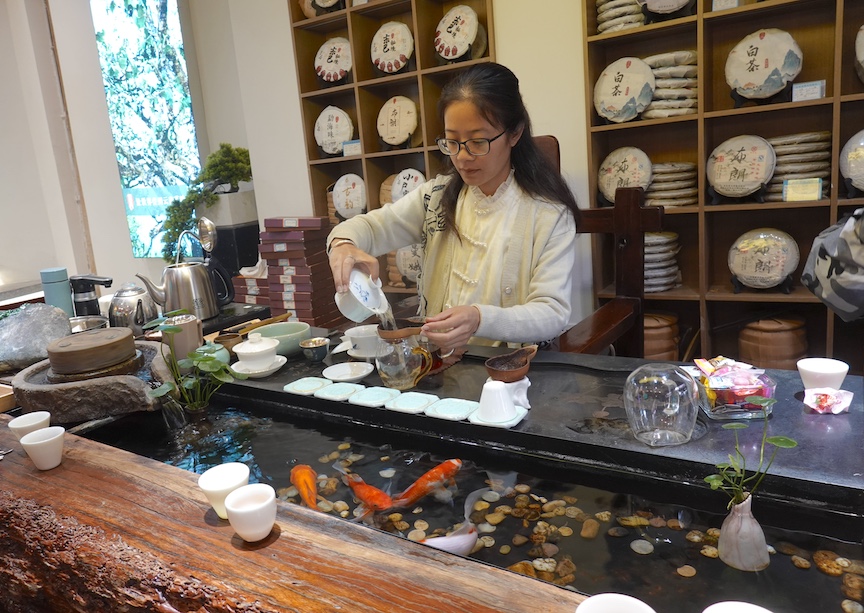
Baixu Fong sells tea, silver and jade on Xianwen Alley (also called Influencers Lane) in Lijiang. Note the compressed discs of Pu’er tea on the shelves behind store manager Xiao He. The large bluish rock on the far left is pure jade. Photo by David DeVoss
Tik Tokers on Parade
Bar Street in Old Town comes alive at night with costumed young women who strike seductive poses while their boyfriends take photos. Most come from China’s Gen Z cohort which numbers around 280 million. Zoomers grew to maturity during a period of uninterrupted economic expansion and have the financial resources to visit Lijiang whenever they wish. Some Chinese worry that ever-growing crowds could lead to over-tourism. But for now, the city remains exceedingly clean and very safe with moderate traffic and affordable hotels.

Chinese Gen Z tourists come to Lijiang, rent costumes from clothing stores, and then spend the rest of the evening taking photos amid the colorful flowers and lights that complement the canals and bars of Lijiang’s Old Town. Photos by David DeVoss
Outside Lijiang the Tea Horse Road is a modern four-lane divided highway that follows the Yangtze River upstream past just harvested corn and tobacco fields now being prepared for barley. It’s a beautiful day, pleasantly warm, and the sun…the sun? Somehow it seems much closer. Yet rather than exuding heat it burns with a brilliant, penetrating force in the rarefied mountain air. On the floor of my car’s back seat is a basket filled with water bottles, bags of cookies, several Snickers bars and six sticks of yak jerky. Unfortunately, there’s not a yak in sight, nor horse for that matter.
Tacheng: Elevation 8,470 ft or 2,580 m
The Land Rover is heading for Tacheng, a temperate area of terraced rice fields between the Yangtze and Mekong Rivers known for its proximity to the endangered Yunnan Golden Monkey. But our ultimate destination is Buddha Mountain’s Lai Yuan Si monastery and the nearby Dharma Cave. The cave is high on the side of a mountain, and as the car climbs up the narrow pilgrimage road the view from the car window is one of driving above a gauzy blanket of clouds with the valley floor two miles below intermittently visible.
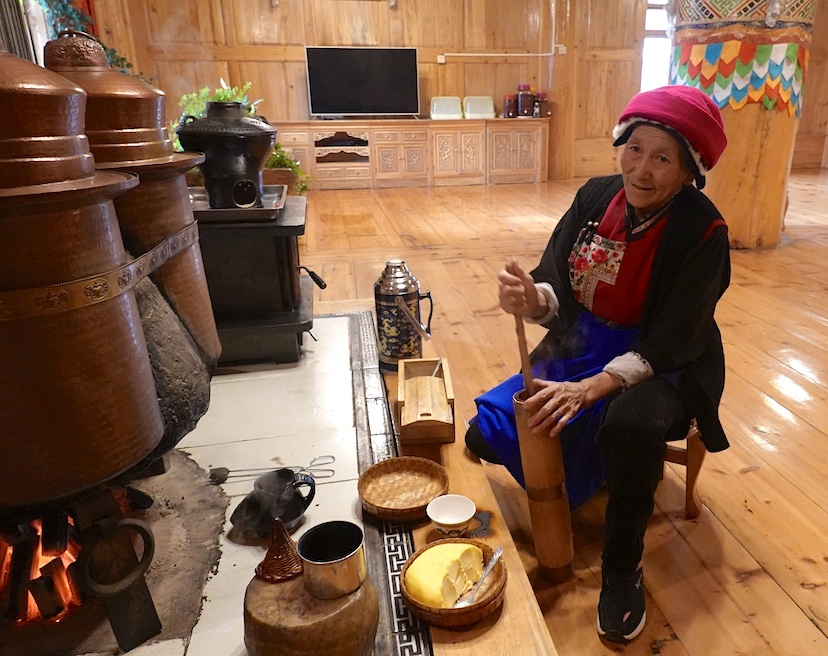
Throughout Tibet and along the Tea Horse Road in Yunnan no home dinner party is complete without yak butter tea and a barley dough called tsampa. Put tea in a churn with a bit of salt and a generous portion of yak butter. Pour the resulting mixture in a teacup and mix what is left with barley flour to make tsampa. A bit of honey added to the barley paste (which is eaten with fingers) adds flavor. Photo by David DeVoss
After reaching the monastery it’s necessary to hike to the cave past a succession of small Ihabtse, ascending piles of rock from which prayer banners often extend. Tibetan Buddhists believe the heaps of stone help appease shidag, a mountain god who can cause landslides if he feels he’s being ignored.
Immediately inside the cave’s entrance visitors are confronted by the imperious stare of the protector god Mahala. The object of his care is Din Zhu Thenring, a Chinese-born monk praying a dozen steps away in an alcove swirling with incense and the sound of bells. When I ask through an interpreter if we can speak, he puts down his prayer wheel and a wooden tablet inscribed with sutras. “I went to Lhasa at age 11 to become a monk and have been living here since 1985 to help rebuild the monastery and improve myself with study,” he says. “I pray from 8 am to noon and every two hours at night.”
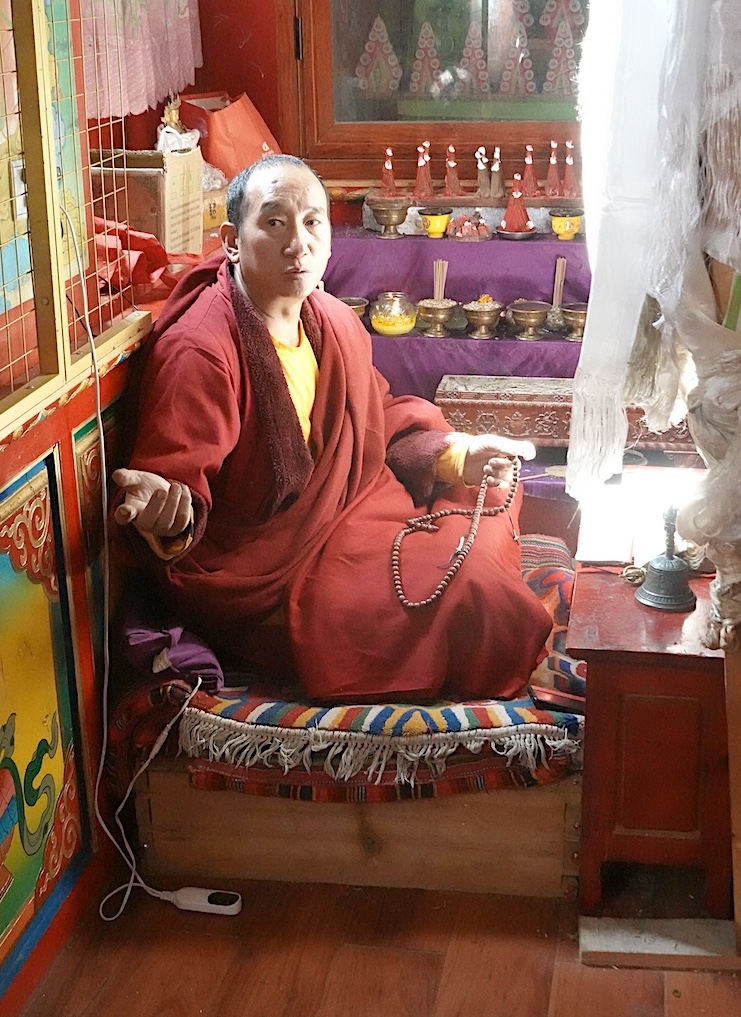
Buddhist monk Din Zhu Thenring spends every morning and part of each night praying in the Buddha Cave connected to the Lai Yuan Si monastery outside Tacheng. Photo by David DeVoss
I figure I have one more question, so I ask, “For what do you pray?” During the translation, the monk closed his eyes and manipulated his prayer beads before responding: “In 140 years, every person now living will be gone. Many existing countries will have new names. But we and the people who replace us all belong to the same family. I pray that people will unite with positive values.”
Wheel of Life
On the way back to the cave entrance my guide, Ring Chen, pointed to a large Wheel of Life mural on the cave wall in which humans searched for positive karma. I wondered where Heaven was located on the chart and was told that only those who reach spiritual enlightenment would be allowed to enter the mythical Buddhist Pure Land called Shambala located in the higher reaches of the Himalayas.
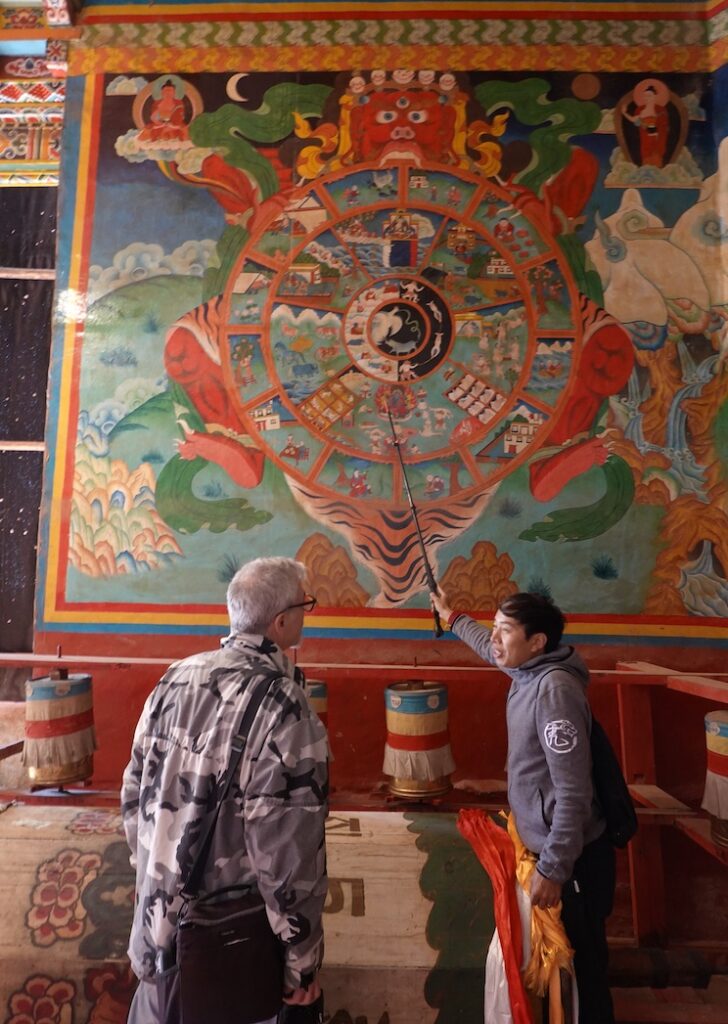
Buddhist Wheel of Life Photo by David DeVoss
As the SUV descended Buddha Mountain rolling past the occasional lhabtse, I realized I didn’t know all the words to a single song about Heaven. But I remembered most of the lyrics to Three Dog Night’s “Shambala.” Where was the mythical kingdom? My next stop was Shangri-La. Maybe I’d find a clue there. Until then I’d enjoy the earworm and the yak jerky.
Wash away my troubles, wash away my pain
With the rain in Shambala
Wash away my sorrow, wash away my shame
With the rain in Shambala…
Everyone is lucky, everyone is kind
On the road to Shambala
Everyone is happy, everyone is so kind
On the road to Shambala…
How does your light shine, in the halls of Shambala?
Shangri-La: Elevation 10,368 ft or 3,160 m
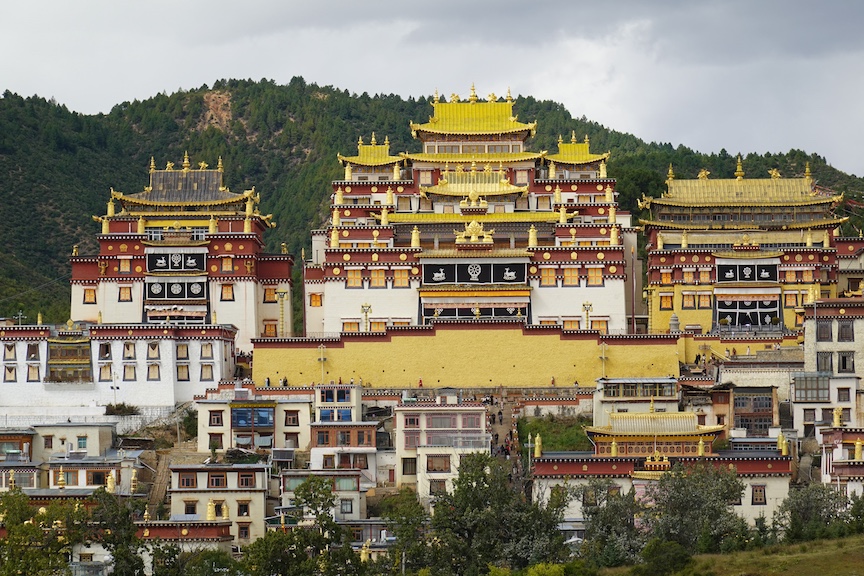
Songzanlin Monastert in Shangri-La often is called “Little Potala Palace.” Photo by David DeVoss
Shangri-La is the last large town before the Tibetan border on the Tea Horse Road. Two decades ago, it was called by its Tibetan name Gyalthang, but in 2001 the Chinese government renamed it Shangri-La to encourage tourism development. The name evokes the fictional land of Shangri-La in the 1933 James Hilton novel Lost Horizon. Along with massive investment came a modern airport, paved streets, reliable Internet and a 60-ton Golden Prayer Wheel rising 21 meters on the edge of the gentrified Dukezong Ancient Town.
Shangri-La’s branding works because of the presence of Songzanlin Monastery, which soars above the city much like Potala Palace does in Lhasa. Built in 1679, the complex was ransacked during the Cultural Revolution (1965 to 1975), but today has 700 monks and has regained its reputation as the largest monastery in Western China.
Because of its size and history Songzanlin is called “Little Potala Palace,” but it exudes an affluence Potala lacks. It’s circumambulatory passage around the main shrine has plenty of natural light and is lined with burnished prayer wheels. Its lamasery is famed for Buddhist scholarship. Its main hall has a 26 ft. tall statue of the Shakyamuni Buddha and an altar illuminated by large yak-butter lamps.
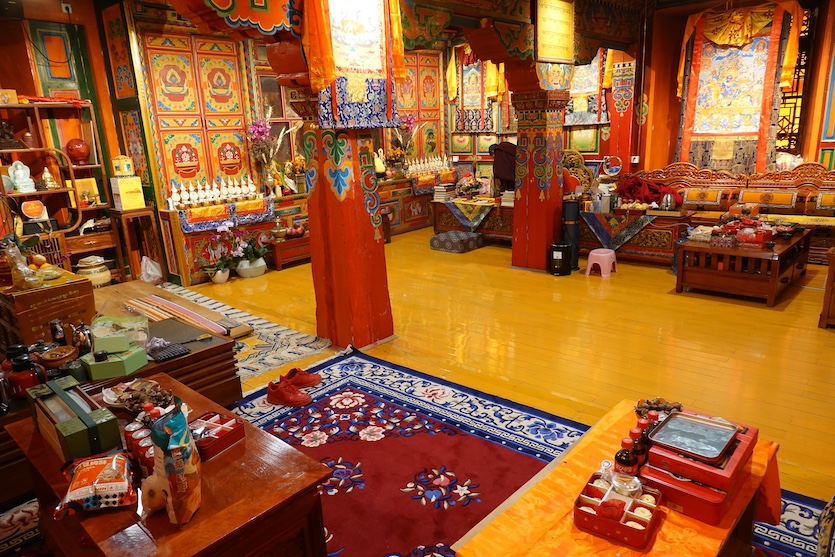
Shangri-La’s Songzanlin Monastery was built around the same time as the 17th Century renovation of Lhasa’s Potala Palace and suffered the same 20th Century desecration by Red Guards as Potala. But today it is in much better shape, perhaps because it is the focal point of a tourism destination. Photo by David DeVoss
Yaks vs. American Buffalo
Yaks are easy to maintain. Leave them alone and they will graze all day in an open field even in places like Shangri-La. The meat tastes like American buffalo and most cafes in Tibet and northwest Yunnan sell yak burgers, yak steak and yak curry. But a yak’s greatest gift is the butter from its milk.
The Tea Horse Road remained a vital artery until the end of the Second World War. In return for horses sent to China over the centuries, Tibet received tea that could be mixed with yak butter and salt. In a massive mountain kingdom unable to grow fruit or vegetables. Yak Butter Tea (bod ja) became a vital dietary supplement that could be combined with barley flour to make a filling paste called tsampa. Many people worry that by succumbing to outside influences and globalization the butter tea diet is being replaced by pizza, instant noodles, white rice and soft drinks with a resulting decline in health.
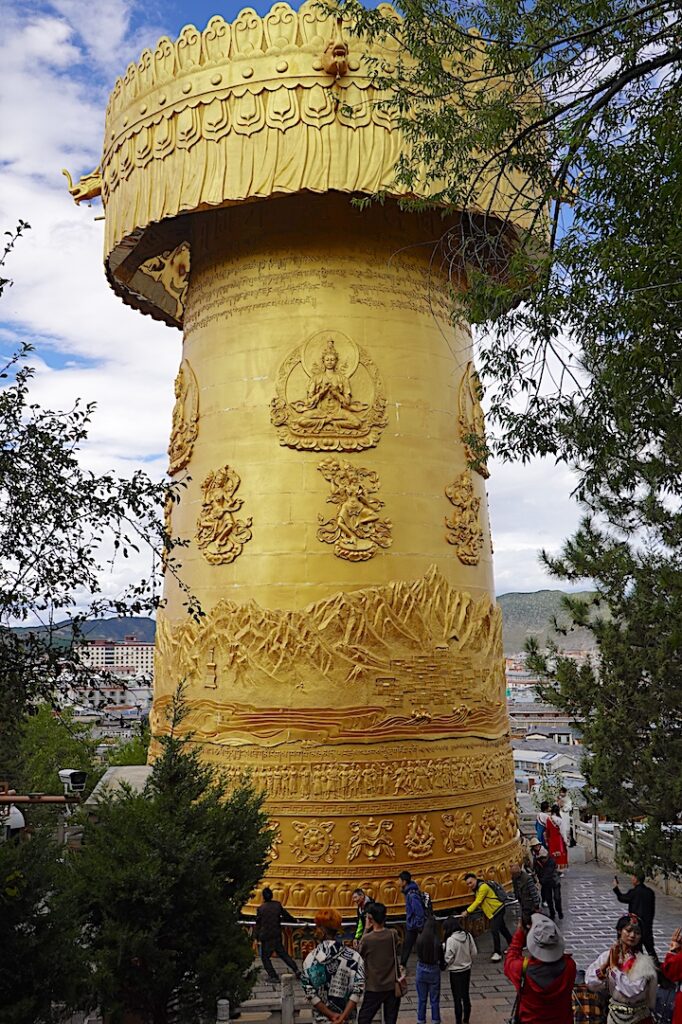
Prayer wheels come in all different sizes. But at a height of 21 meters, Shangri-La’s Golden Prayer Wheel is the biggest in the world. Hopefully, people who help turn the 60-ton wheel will earn much merit and positive karma. Photo by David DeVoss
Searching For Shambala
Shangri-La is said to be the portal to Shambala, so on the flight to Lhasa, I looked out the window trying to glimpse the mythical land of Buddhist perfection. The aircraft was cruising at 30,000 ft yet the snowy mountain ridges seemed incredibly close. There were no visible donkey paths or goat tracks. Yet despite the seeming absence of human habitation, one tiny lhabtse had taken root on a lonely promontory. Were Shambala’s enlightened waiting for discovery? If so, I hoped their karma had given them patience, for like the ancient Chinese proverb proclaims: “The mountains are high and the emperor far away.” ![]()
David DeVoss is the editor and senior correspondent of the East-West News Service. His other reports from China cover Macau, Yangzhou and Shanghai.

